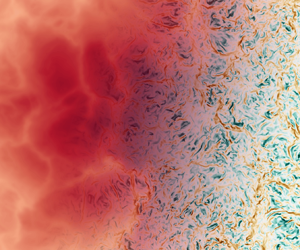Published online by Cambridge University Press: 06 February 2024

Supergranule aggregation, i.e. the gradual aggregation of convection cells to horizontally extended networks of flow structures, is a unique feature of constant heat flux-driven turbulent convection. In the present study, we address the question if this mechanism of self-organisation of the flow is present for any fluid. Therefore, we analyse three-dimensional Rayleigh–Bénard convection at a fixed Rayleigh number  ${Ra} \approx 2.0 \times 10^{5}$ across
${Ra} \approx 2.0 \times 10^{5}$ across  $4$ orders of Prandtl numbers
$4$ orders of Prandtl numbers  ${Pr} \in [10^{-2}, 10^{2}]$ by means of direct numerical simulations in horizontally extended periodic domains with aspect ratio
${Pr} \in [10^{-2}, 10^{2}]$ by means of direct numerical simulations in horizontally extended periodic domains with aspect ratio  $\varGamma = 60$. Our study confirms the omnipresence of the mechanism of supergranule aggregation for the entire range of investigated fluids. Moreover, we analyse the effect of
$\varGamma = 60$. Our study confirms the omnipresence of the mechanism of supergranule aggregation for the entire range of investigated fluids. Moreover, we analyse the effect of  ${Pr}$ on the global heat and momentum transport, and clarify the role of a potential stable stratification in the bulk of the fluid layer. The ubiquity of the investigated mechanism of flow self-organisation underlines its relevance for pattern formation in geophysical and astrophysical convection flows, the latter of which are often driven by prescribed heat fluxes.
${Pr}$ on the global heat and momentum transport, and clarify the role of a potential stable stratification in the bulk of the fluid layer. The ubiquity of the investigated mechanism of flow self-organisation underlines its relevance for pattern formation in geophysical and astrophysical convection flows, the latter of which are often driven by prescribed heat fluxes.